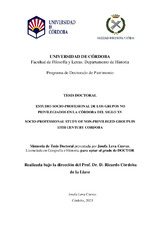Mostrar el registro sencillo del ítem
Estudio socio-profesional de los grupos no privilegiados en la Córdoba del siglo XV
| dc.contributor.advisor | Córdoba de la Llave, Ricardo | |
| dc.contributor.author | Leva Cuevas, Josefa | |
| dc.date.accessioned | 2023-07-26T09:00:45Z | |
| dc.date.available | 2023-07-26T09:00:45Z | |
| dc.date.issued | 2023 | |
| dc.identifier.uri | http://hdl.handle.net/10396/25862 | |
| dc.description.abstract | Esta tesis doctoral pretende la realización de una investigación sobre la estructura socioprofesional de la población de la ciudad de Córdoba a fines de la Edad Media y principios de la época moderna, mediante el estudio de la sociedad no privilegiada en su estructura interna y en sus relaciones con el conjunto social de la urbe. Para ello se ha llevado a cabo el análisis de estos grupos populares desde el punto de vista de su estructura socio-laboral, definiendo su componente demográfico, distribución por sectores urbanos, ubicación de los lugares de residencia y trabajo, perfiles económicos (dedicación laboral y niveles de vida) y relaciones sociales. Ello ha sido posible gracias a la existencia de una documentación idónea que se refiere a la ciudad de Córdoba en dicho período, localizada en el Archivo Histórico Provincial y Archivo Municipal de Córdoba: protocolos notariales y padrones de 1509, 1536, 1537 y 1549. La documentación anterior se complementa para tener un conocimiento de la geografía del mundo del trabajo en las diversas collaciones cordobesas. Así se han analizado aspectos como demografía, composición de la población por barrios, distribución espacial de la vecindad y ubicación de los lugares de trabajo, rasgos urbanísticos laborales de la ciudad y sus collaciones y dedicación profesional de la población. Tras este estudio se ha podido llegar a conclusiones como: - Relación entre demografía y vitalidad artesano-comercial. - Córdoba era una ciudad industrializada, que llevaba implícita la terciarización para dar salida a los productos artesanales, incluyendo también los agrícolas y ganaderos. - Las collaciones más industriales eran las menos terciarizadas. Destacan entre las primeras San Pedro, San Andrés, Santa María y San Nicolás de la Axerquía. Además el porcentaje de los sectores secundario y terciario en todas las collaciones, siempre estuvo por encima del 20%. - Sobre la variedad de oficios de las distintas ramas profesionales en la ciudad, se situaron entre los diez primeros: escribano, criado/a, fraile, trapero, mercader, zapatero, veinticuatro, correero, carpintero y sastre. - Fuerte demanda de inmuebles en estas collaciones más industriales y comerciales, con gran especulación. - Todas las peculiaridades del mundo laboral repercutían en las collaciones, quedando definidas por la distribución espacial de los oficios en ellas. | es_ES |
| dc.description.abstract | This doctoral thesis aims to carry out research on the socio-professional structure of the population of the city of Córdoba at the end of the Middle Ages and the beginning of the modern era, through the study of the non-privileged society in its internal structure and in its relations with the social group of the city. To this end, an analysis of these popular groups has been carried out from the point of view of their socio-labour structure, defining their demographic component, distribution by urban sectors, location of places of residence and work, economic profiles (work dedication and living standards) and social relations. This has been possible thanks to the existence of suitable documentation that refers to the city of Córdoba in that period, located in the Provincial Historical Archive and Municipal Archive of Córdoba: notarial protocols and registers of 1509, 1536, 1537 and 1549. Previous documentation is complemented to have a knowledge of the geography of the world of work in the various Cordovan collations. Thus, aspects such as demography, composition of the population by neighborhoods, spatial distribution of the neighborhood and location of workplaces, urban labor characteristics of the city and its collations and professional dedication of the population have been analyzed. After this study it has been possible to reach conclusions such as: - Relationship between demography and artisan-commercial vitality. - Córdoba was an industrialized city, which implicitly included outsourcing to provide an outlet for artisanal products, including agricultural and livestock products. - The most industrial collations were the least outsourced. Outstanding among the first are San Pedro, San Andrés, Santa María and San Nicolás de la Axerquía. In addition, the percentage of the secondary and tertiary sectors in all collations was always above 20%. - On the variety of trades of the different professional branches in the city, they were among the top ten: notary, servant, friar, ragpicker, merchant, shoemaker, twenty-four, courier, carpenter and tailor. - Strong demand for real estate in these more industrial and commercial neighborhoods, with great speculation. - All the peculiarities of the world of work affected the collations, being defined by the spatial distribution of the trades in them. | es_ES |
| dc.format.mimetype | application/pdf | es_ES |
| dc.language.iso | spa | es_ES |
| dc.publisher | Universidad de Córdoba, UCOPress | es_ES |
| dc.rights | https://creativecommons.org/licenses/by-nc-nd/4.0/ | es_ES |
| dc.subject | Córdoba (España) | es_ES |
| dc.subject | Población | es_ES |
| dc.subject | Edad Media | es_ES |
| dc.subject | Edad Moderna | es_ES |
| dc.subject | Sociedad | es_ES |
| dc.subject | Economía | es_ES |
| dc.title | Estudio socio-profesional de los grupos no privilegiados en la Córdoba del siglo XV | es_ES |
| dc.title.alternative | Socio-professional study of non-privileged groups in 15th Century Cordoba | es_ES |
| dc.type | info:eu-repo/semantics/doctoralThesis | es_ES |
| dc.rights.accessRights | info:eu-repo/semantics/openAccess | es_ES |

